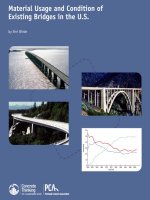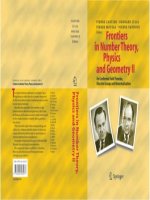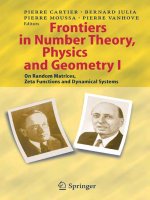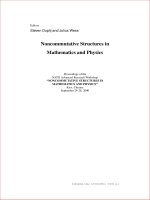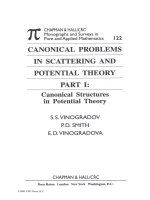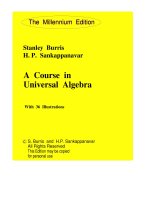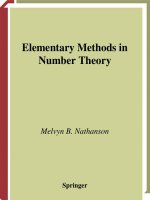- Trang chủ >>
- Khoa Học Tự Nhiên >>
- Vật lý
Canonical structures in potential theory - s s vinogradov, p d smith, e d vinogradova
Bạn đang xem bản rút gọn của tài liệu. Xem và tải ngay bản đầy đủ của tài liệu tại đây (5.94 MB, 364 trang )
©2001 CRC Press LLC
To our children
©2001 CRC Press LLC
Contents
1Laplace’sEquation
1.1.1Cartesiancoordinates
1.1.2Cylindricalpolarcoordinates
1.1.3Sphericalpolarcoordinates
1.1.4Prolatespheroidalcoordinates
1.1.5Oblatespheroidalcoordinates
1.1.6Ellipticcylindercoordinates
1.1.7Toroidalcoordinates
1.1Laplace’sequationincurvilinearcoordinates
1.2.1Cartesiancoordinates
1.2.2Cylindricalpolarcoordinates
1.2.3Sphericalpolarcoordinates
1.2.4Prolatespheroidalcoordinates
1.2.5Oblatespheroidalcoordinates
1.2.6Ellipticcylindercoordinates
1.2.7Toroidalcoordinates
1.2SolutionsofLaplace’sequation:separationofvariables
1.3Formulationofpotentialtheoryforstructureswithedges
1.4.1Thedefinitionmethod
1.4.2Thesubstitutionmethod
1.4.3Noble’smultiplyingfactormethod
1.4.4TheAbelintegraltransformmethod
1.4Dualequations:aclassificationofsolutionmethods
1.5Abel’sintegralequationandAbelintegraltransforms
1.6Abel-typeintegralrepresentationsofhypergeometricfunctions
1.7Dualequationsandsingle-ordouble-layersurfacepotentials
2SeriesandIntegralEquations
2.1DualseriesequationsinvolvingJacobipolynomials
2.2Dualseriesequationsinvolvingtrigonometricalfunctions
2.3DualseriesequationsinvolvingassociatedLegendrefunctions
2.4.1TypeAtripleseriesequations
2.4.2TypeBtripleseriesequations
2.4 Symmetric triple series equations involving Jacobi polynomials
©2001 CRC Press LLC
2.5Relationshipsbetweenseriesandintegralequations
2.6DualintegralequationsinvolvingBesselfunctions
2.7Nonsymmetricaltripleseriesequations
2.8Coupledseriesequations
2.9Aclassofintegro-seriesequations
3ElectrostaticPotentialTheoryforOpenSphericalShells
3.1Theopenconductingsphericalshell
3.2.1Approximateanalyticalformulaeforcapacitance
3.2Asymmetricalpairofopensphericalcapsandthespherical
barrel
3.3Anasymmetricalpairofsphericalcapsandtheasymmetric
barrel
3.4Themethodofinversion
3.5Electrostaticfieldsinasphericalelectroniclens
3.6Frozenmagneticfieldsinsidesuperconductingshells
3.7Screeningnumberofsuperconductingshells
4ElectrostaticPotentialTheoryforOpenSpheroidalShells
4.1Formulationofmixedboundaryvalueproblemsinspheroidal
geometry
4.2Theprolatespheroidalconductorwithonehole
4.3Theprolatespheroidalconductorwithalongitudinalslot
4.4Theprolatespheroidalconductorwithtwocircularholes
4.5Theoblatespheroidalconductorwithalongitudinalslot
4.6Theoblatespheroidalconductorwithtwocircularholes
4.7.1Openspheroidalshells
4.7.2Spheroidalcondensors
4.7Capacitanceofspheroidalconductors
5ChargedToroidalShells
5.1Formulationofmixedboundaryvalueproblemsintoroidalge-
ometry
5.2Theopenchargedtoroidalsegment
5.3Thetoroidalshellwithtwotransversalslots
5.4Thetoroidalshellwithtwolongitudinalslots
5.5Capacitanceoftoroidalconductors
5.6.1Thetoroidalshellwithoneazimuthalcut
5.6 Anopentoroidal shell with azimuthal cuts
©2001 CRC Press LLC
5.6.2Thetoroidalshellwithmultiplecuts
5.6.3Limitingcases
6PotentialTheoryforConicalStructureswithEdges
6.1Non-coplanaroppositelychargedinfinitestrips
6.2Electrostaticfieldsofachargedaxisymmetricfiniteopenconi-
calconductor
6.3Theslottedhollowspindle
6.4Asphericalshellwithanazimuthalslot
7Two-dimensionalPotentialTheory
7.1Thecirculararc
7.2Axiallyslottedopencircularcylinders
7.3Electrostaticpotentialofsystemsofchargedthinstrips
7.4Axially-slottedellipticcylinders
7.5Slottedcylindersofarbitraryprofile
8MoreComplicatedStructures
8.1Rigoroussolutionmethodsforchargedflatplates
8.2.1Thespherically-curvedellipticplate
8.2Thechargedellipticplate
8.3Polygonalplates
8.4Thefinitestrip
8.5Coupledchargedconductors:thesphericalcapandcirculardisc
ANotation
BSpecialFunctions
B.1TheGammafunction
B.2Hypergeometricfunctions
B.3.1TheassociatedLegendrepolynomials
B.3.2TheLegendrepolynomials
B.3Orthogonalpolynomials:Jacobipolynomials,Legendrepoly-
nomials
B.4.1OrdinaryLegendrefunctions
B.4 Associated Legend refunctions
©2001 CRC Press LLC
B.4.2Conicalfunctions
B.4.3AssociatedLegendrefunctionsofintegerorder
B.5.1SphericalBesselfunctions
B.5.2ModifiedBesselfunctions
B.5Besselfunctions
B.6Theincompletescalarproduct
CElementsofFunctionalAnalysis
C.1Hilbertspaces
C.2Operators
C.3TheFredholmalternativeandregularisation
DTransformsandIntegrationofSeries
D.1FourierandHankeltransforms
D.2Integrationofseries
References
©2001 CRC Press LLC
Preface
Potential theory has its roots in the physical sciences and continues to find
application in diverse areas including electrostatics and elasticity. From a
mathematical point of view, the study of Laplace’s equation has profoundly
influenced the theory of partial differential equations and the development of
functional analysis. Together with the wave operator and the diffusion opera-
tor, its study and application continue to dominate many areas of mathemat-
ics, physics, and engineering. Scattering of electromagnetic or acoustic waves
is of widespread interest, because of the enormous number of technological ap-
plications developed in the last century, from imaging to telecommunications
and radio astronomy.
The advent of powerful computing resources has facilitated numerical mod-
elling and simulation of many concrete problems in potential theory and scat-
tering. The many methods developed and refined in the last three decades
have had a significant impact in providing numerical solutions and insight into
the important mechanisms in scattering and associated static problems. How-
ever, the accuracy of present-day purely numerical methods can be difficult
to ascertain, particularly for objects of some complexity incorporating edges,
re-entrant structures, and dielectrics. An example is the open metallic cavity
with a dielectric inclusion. The study of closed bodies with smooth surfaces is
rather more completely developed, from an analytical and numerical point of
view, and computational algorithms have attained a good degree of accuracy
and generality. In contradistinction to highly developed analysis for closed
bodies of simple geometric shape – which was the subject of Bowman, Senior,
and Uslenghi’s classic text on scattering [6] – structures with edges, cavities,
or inclusions have seemed, until now, intractable to analytical methods.
Our motivation for this two-volume text on scattering and potential theory
is to describe a class of analytic and semi-analytic techniques for accurately de-
termining the diffraction from structures comprising edges and other complex
cavity features. These techniques rely heavily on the solution of associated
potential problems for these structures developed in Part I.
These techniques are applied to various classes of canonical scatterers, of
particular relevance to edge-cavity structures. There are several reasons for
focusing on such canonical objects. The exact solution to a potential theory
problemordiffractionproblemisinterestinginitsownright.AsBowmanet
al. [6] state, most of our understanding of how scattering takes place is ob-
tained by detailed examination of such representative scatterers. Their study
provides an exact quantification of the effects of edges, cavities, and inclusions.
©2001 CRC Press LLC
This is invaluable for assessing the relative importance of these effects in other,
more general structures. Sometimes the solution developed in the text is in
the form of a linear system of equations for which the solution accuracy can be
determined; however, the same point about accurate quantification is valid.
Such solutions thus highlight the generic difficulties that numerical methods
must successfully tackle for more general structures. Reliable benchmarks,
against which a solution obtained by such general-purp ose numerical meth-
ods can be verified, are needed to establish confidence in the validity of these
computational methods in wider contexts where analysis becomes impossible.
Exact or semi-analytic solutions are valuable elsewhere: in inverse scattering,
exact solutions may pinpoint special effects and distinguish between physi-
cally real effects and artefacts of the computational process. Moreover, many
canonical structures are of direct technological interest, particularly where a
scattering process is dominated by that observed in a related canonical struc-
ture.
Mathematically, we solve a clas s of mixed boundary value problems and de-
velop numerical formulations for computationally stable, rapidly converging
algorithms of guaranteed accuracy. The potential problems and diffraction
problems are initially formulated as dual (or multiple) series equations, or
dual (or multiple) integral equations. Central to the technique is the idea
of regularisation. The general concept of regularisation is well established in
many areas of mathematics. In this context, its main feature is the transfor-
mation of the badly behaved or singular part of the initial equations, describing
a potential distribution or a diffraction process, to a well behaved set of equa-
tions (technically, second-kind Fredholm equations). Physically, this process
of semi-inversion corresponds to solving analytically s ome associated potential
problem, and utilising that solution to determine the full wave scattering.
The two volumes of this text are close ly connected. Part I develops the
theory of series equations and integral equations, and solves m ixed bound-
ary potential problems (mainly electrostatic ones) for structures with cavities
and edges. The theory and structure of the dual equations that arise in this
process reflect new developments and refinements since the major exposition
of Sneddon [55]. In our unified approach, transformations connected with
Abel’s integral equation are employed to invert analytically the singular part
of the operator defining the potential. Three-dimensional structures exam-
ined include shells and cavities obtained by opening apertures in canonically
shaped closed surfaces; thus a variety of spherical and spheroidal cavities and
toroidal and conical shells are considered. Although the main thrust of both
volumes concerns three-dimensional effects, some canonical two-dimensional
structures, such as slotted elliptical cylinders and various flat plates, are con-
sidered. Also, to illustrate how regularisation transforms the standard integral
equations of potential theory and benefits subsequent numerical computa-
tions, the method is applied to a noncanonical structure, the singly-slotted
cylinder of arbitrary cross-section.
Part II examines diffraction of acoustic and electromagnetic waves from
©2001 CRC Press LLC
similar classes of open structures with edges or cavities. The rigorous regu-
larisation procedure relies on the techniques solutions developed in Part I to
produce effective algorithms for the complete frequency range, quasi-static to
quasi-optical. Physical interpretation of explicit mathematical solutions and
relevant applications are provided.
The two volumes aim to provide an account of some mathematical develop-
ments over the last two decades that have greatly enlarged the set of soluble
canonical problems of real physical and engineering significance. They gather,
perhaps for the first time, a s atisfactory mathematical description that accu-
rately quantifies the physically relevant scattering mechanisms in complex
structures. Our selection is not exhaustive, but is chosen to illustrate the
types of structures that may be analysed by these methods, and to provide a
platform for the further analysis of related structures.
In developing a unified treatment of potential theory and diffraction, we
have chosen a concrete, rather than an abstract or formal style of analysis.
Thus, constructive methods and explicit s olutions from w hich practical nu-
merical algorithms can be implemented, are obtained from an intensive and
unified study of series equations and integral equations.
We hope this book will be useful to both new researchers and experienced
specialists. Most of the necessary tools for the solution of series equations
and integral equations are developed in the text; allied material on special
functions and functional analysis is collated in an appendix so that the book
is accessible to as wide a readership as possible. It is addressed to mathemati-
cians, physicists, and electrical engineers. The text is suitable for postgraduate
courses in diffraction and potential theory and related mathematical methods.
It is also suitable for advanced-level undergraduates, particularly for project
material.
We wish to thank our partners and families for their support and encour-
agement in writing this book. Their unfailing good humour and advice played
a key role in bringing the text to fruition.
©2001 CRC Press LLC
Chapter 1
Laplace’s Equation
Laplace’s equation is one of the most important partial differential equations
that arises in the application of mathematics to physical phenomena. It occurs
in diverse contexts, including electrostatics, magnetostatics, elasticity, grav-
itation, steady-state heat conduction, incompressible fluid flow, and many
related areas desc ribed in, for example, [44] and [13].
Common to these disciplines is the notion of a potential ψ, which is a scalar
function of spatial position. We will be particularly interested in the electro-
static context, where the potential ψ is constant on equipotential surfaces,
and the associated electric field vector
−→
E is expressed via the gradient
−→
E = −∇ψ. (1. 1)
This vector lies along the direction of most rapid decrease of ψ. Gauss’ law
states that the divergence of the elec tric field is proportional to charge density
ρ at e ach point in space,
∇.
−→
E = 4πρ. (1. 2)
The proportionality factor in Equation (1. 2) depends upon the choice of
units. We employ Gaussian units [20] throughout; if Syst`eme International
(SI) units are employed, the right-hand side of (1. 2) is divided by 4πε
0
where
ε
o
denotes free space permittivity. (To convert capacitances from Gaussian
to SI units, multiply by 4πε
0
).
From (1. 1) and (1. 2), Poisson’s equation follows,
∇. (∇ψ) = ∇
2
ψ = −4πρ. (1. 3)
This equation describes how the potential is determined by the charge distri-
bution in some region of space.
Now consider an electrostatic field with associated potential ψ. If a perfectly
conducting surface S is immersed in this field, a charge distribution ρ
i
is
induced on the surface; it has an associated potential ψ
i
satisfying (1. 3).
The total potential Ψ = ψ + ψ
i
is constant on S (an equipotential surface),
the total electric field −∇Ψ is normal to S (at each point), and because there
are no charges except on S, the total potential satisfies Laplace’s equation,
∇
2
ψ = 0, (1. 4)
©2001 CRC Press LLC
at every point of space except on S.
In order to obtain a unique solution that is physically relevant, this partial
differential equation must be complemented by appropriate boundary condi-
tions; for example, the potential on one or more metallic conductors might
be specified to be of unit value, and Laplace’s equation is to be solved in the
region excluding the conductors, but subject to this specification on the con-
ductor surface. If one of the conductors encloses a (finite) region of interest,
such boundary conditions may be sufficient to specify the required solution
uniquely; however, in unbounded regions, some additional specification of the
behaviour of the potential at infinity is required. Moreover, the presence of
sharp edges on the bounding conducting surfaces may require that additional
constraints, equivalent to the finiteness of energy, be imposed to ensure that
a physically relevant solution is uniquely defined by Laplace’s equation.
In this book we shall be interested in analytic and semi-analytic methods for
solving Laplace’s equation with appropriate boundary and other conditions.
To make substantive progress, we shall consider orthogonal coordinate systems
in which Laplace’s equation is separable (i.e., it can be solved by the method
of separation of variables), and the conductors occupy part or whole of a
coordinate surface in these systems.
Laplace’s equation can be solved by the method of separation of variables
only when the boundary conditions are enforced on a complete coordinate
surface (e.g., the surface of a sphere in the spherical coordinate system). As
indicated in the preface, it is important to emphasize that the methods de-
scribed in this book apply to a much wider class of surfaces, where the bound-
ary conditions (describing, say, the electrostatic potential of a conductor) are
prescribed on only part of a coordinate surface in the following way. Let
u
1
, u
2
, and u
3
be a system of coordinates in which the three sets of coordinate
surfaces, u
1
= constant, u
2
= constant, and u
3
= constant, are mutually or-
thogonal. We shall consider portions of a co ordinate surface typically specified
by
u
1
= constant, a ≤ u
2
≤ b (1. 5)
where a and b are fixed. For example, a spherical cap of radius a and sub-
tending an angle θ
o
(at the centre of the appropriate sphere) may be specified
in the spherical coordinate system (r, θ, φ) by
r = a, 0 ≤ θ ≤ θ
0
, 0 ≤ φ ≤ 2π. (1. 6)
The determination of the electrostatic potential surrounding the cap can be
posed as a mixed boundary value problem, and can be solved by the analytic
methods of this book, despite its insolubility by the method of separation of
variables.
Although the type of surface specified by (1. 5) is somewhat restricted, it
includes many cases not merely of mathematical interest, but of substantive
©2001 CRC Press LLC
physicalandtechnologicalinterestaswell;theclassofsurfacesforwhichana-
lyticsolutionstothepotentialtheoryproblem(ofsolvingLaplace’sequation)
canbefoundisthusconsiderablyenlarged,beyondthewell-establishedclass
ofsolutionsobtainedbyseparationofvariables(see,forexample[54]).Since
itwillbecentraltolaterdevelopments,Sections1.1and1.2brieflydescribe
theformofLaplace’sequationinsomeoftheseorthogonalcoordinatesys-
tems,andthesolutionsgeneratedbytheclassicalmethodofseparationof
variables.
Theformulationofpotentialtheoryforstructureswithedgesisexpounded
inSection1.3.Fortheclassofsurfacesdescribedabove,dual(ormultiple)
seriesequationsarisenaturally,asdodual(ormultiple)integralequations.
VariousmethodsforsolvingsuchdualseriesequationsaredescribedinSec-
tion1.4,includingtheAbelintegraltransformmethodthatisthekeytool
employedthroughoutthistext.ItexploitsfeaturesofAbel’sintegralequation
(describedinSection1.5)andAbel-typeintegralrepresentationsofLegendre
polynomials,Jacobipolynomials,andrelatedhypergeometricfunctions(de-
scribedinSection1.6).InthefinalSection(1.7),theequivalenceofthedual
seriesapproachandthemoreusualintegralequationapproach(employing
single-ordouble-layersurfacedensities)topotentialtheoryisdemonstrated.
1.1Laplace’sequationincurvilinearcoordinates
ThestudyofLaplace’sequationinvariouscoordinatesystemshasalong
history,generating,amongstotheraspects,manyofthespecialfunctionsof
appliedmathematicsandphysics(Besselfunctions,Legendrefunctions,etc.).
Inthissectionwegathermaterialofareferencenature;foragreaterdepth
ofdetail,werefertheinterestedreadertooneofthenumeroustextswritten
onthesetopics,suchas[44],[32]or[74].
HereweconsiderLaplace’sequationinthosecoordinatesystemsthatwill
beofconcreteinterestlaterinthisbook;inthesesystemsthemethodof
separationofvariablesisapplicable.Letu
1
,u
2
,andu
3
beasystemofcoor-
dinatesinwhichthecoordinatesurfacesu
1
=constant,u
2
=constant,and
u
3
=constantaremutuallyorthogonal(i.e.,intersectorthogonally).Fixa
point(u
1
,u
2
,u
3
)andconsidertheelementaryparallelepipedformedalongthe
coordinatesurfaces,asshowninFigure1.1.
Thus O, A, B, and C have coordinates (u
1
, u
2
, u
3
), (u
1
+du
1
, u
2
, u
3
), (u
1
, u
2
+
du
2
, u
3
), and (u
1
, u
2
, u
3
+ du
3
), respectively. The length ds of the diagonal
line segment connecting (u
1
, u
2
, u
3
) and (u
1
+ du
1
, u
2
+ du
2
, u
3
+ du
3
) is given
by
ds
2
= h
2
1
du
2
1
+ h
2
2
du
2
+ h
3
3
du
2
3
(1. 7)
where h
1
, h
2
, and h
3
are the metric coefficients (or Lam´e coefficients, in recog-
©2001 CRC Press LLC
Figure 1.1
The elementary parallelepiped.
nition of the transformation of the Laplacian to general orthogonal coordinates
first effected in [35]).
In terms of the Lam´e coefficients, the lengths of the elementary paral-
lelepiped edges equal h
1
du
1
, h
2
du
2
, and h
3
du
3
, respectively, so that its volume
is h
1
h
2
h
3
du
1
du
2
du
3
. These coefficients depend, in general, upon the coordi-
nates u
1
, u
2
, u
3
and can be calculated explicitly from the functional relation-
ship between rectangular and curvilinear coordinates,
x = x(u
1
, u
2
, u
3
), y = y(u
1
, u
2
, u
3
), z = z(u
1
, u
2
, u
3
). (1. 8)
It is useful to state the relationship between rectangular and curvilinear com-
ponents of any vector
−→
F . Designate by
−→
i
x
,
−→
i
y
,
−→
i
z
the unit rectangular (Carte-
sian) coordinate vectors, and by
−→
i
1
,
−→
i
2
,
−→
i
3
the unit co ordinate vectors in the
orthogonal curvilinear coordinate system; the unit vectors are defined by the
relation (with
−→
r = x
−→
i
x
+ y
−→
i
y
+ z
−→
i
z
):
−→
i
i
=
1
h
i
∂x
∂u
i
−→
i
x
+
∂y
∂u
i
−→
i
y
+
∂z
∂u
i
−→
i
z
=
∂
−→
r
∂u
i
/
∂
−→
r
∂u
i
(1. 9)
where i = 1, 2, 3, and are mutually orthogonal. Then
−→
F = F
x
−→
i
x
+ F
y
−→
i
y
+ F
z
−→
i
z
= F
1
−→
i
1
+ F
2
−→
i
2
+ F
3
−→
i
3
. (1. 10)
Taking inner products yields the following relations:
F
1
= F
x
(
−→
i
x
,
−→
i
1
) + F
y
(
−→
i
y
,
−→
i
1
) + F
z
(
−→
i
z
,
−→
i
1
)
F
2
= F
x
(
−→
i
x
,
−→
i
2
) + F
y
(
−→
i
y
,
−→
i
2
) + F
z
(
−→
i
z
,
−→
i
2
) (1. 11)
F
3
= F
x
(
−→
i
x
,
−→
i
3
) + F
y
(
−→
i
y
,
−→
i
3
) + F
z
(
−→
i
z
,
−→
i
3
)
©2001 CRC Press LLC
h du
33
G
F
H
C
I
A
BO
h du
22
11
h du
Thedifferentialsoftherectangularcoordinatesarelinearfunctionsofthe
curvilinearcoordinates:
dx=
∂x
∂u
1
du
1
+
∂x
∂u
2
du
2
+
∂x
∂u
3
du
3
,
dy=
∂y
∂u
1
du
1
+
∂y
∂u
2
du
2
+
∂y
∂u
3
du
3
,(1.12)
dz=
∂z
∂u
1
du
1
+
∂z
∂u
2
du
2
+
∂z
∂u
3
du
3
.
Comparingtheexpressionforelementarylengthds
2
=dx
2
+dy
2
+dz
2
with
(1.7),andusingorthogonalityofthecoordinatebasisvectors,weobtain
h
2
1
du
2
1
+h
2
2
du
2
2
+h
2
3
du
2
3
=dx
2
+dy
2
+dz
2
;(1.13)
substituting(1.12)into(1.13)andequatinglikecoefficientsshowsthat
h
2
i
=
∂x
∂u
i
2
+
∂y
∂u
i
2
+
∂z
∂u
i
2
(i=1,2,3).(1.14)
Letψ=ψ(u
1
,u
2
,u
3
)beascalarfunctiondependentuponspatialposition,
andlet
−→
A=
−→
A(u
1
,u
2
,u
3
)beavectorfunctionofposition,thethreecompo-
nentsofwhichwillbedenotedA
1
=A
1
(u
1
,u
2
,u
3
),A
2
=A
2
(u
1
,u
2
,u
3
),and
A
3
=A
3
(u
1
,u
2
,u
3
).Wewishtofindthecoordinateexpressionforthegradi-
entofthescalarψ(gradψ)inthissystem,aswellasthedivergence(div
−→
A)
andcirculationorcurl(curl
−→
A)ofthevector
−→
A.
ItfollowsfromFigure1.1thatthefirstcomponentofthegradientis
(grad ψ)
1
= lim
du
1
→0
ψ(u
1
+ du
1
, u
2
, u
3
) − ψ(u
1
, u
2
, u
3
)
h
1
du
1
=
1
h
1
∂ψ
∂u
1
. (1. 15)
Analogously, the other two components are
(grad ψ)
2
=
1
h
2
∂ψ
∂u
2
, (grad ψ)
3
=
1
h
3
∂ψ
∂u
3
. (1. 16)
To determine the divergence, let us calculate the total flux
S
−→
A .
−→
n ds
of the vector
−→
A through the surface S of the elementary parallelepiped, the
flux being calculated in the direction of the external unit normal
−→
n. The flux
through the surface OBHC is A
1
h
2
h
3
du
2
du
3
, whereas the flux through surface
AFGI is
A
1
h
2
h
3
du
2
du
3
+
∂
∂u
1
(A
1
h
2
h
3
)du
1
du
2
du
3
,
©2001 CRC Press LLC
so the net flux through these two surfaces is
∂
∂u
1
(A
1
h
2
h
3
)du
1
du
2
du
3
.
The net flux through the remaining two opposing pairs of surfaces is
∂
∂u
2
(A
2
h
3
h
1
)du
1
du
2
du
3
and
∂
∂u
3
(A
3
h
1
h
2
)du
1
du
2
du
3
.
Thus the total flux through the complete parallelepiped surface is
S
−→
A .
−→
n ds =
∂
∂u
1
(A
1
h
2
h
3
) +
∂
∂u
2
(A
2
h
3
h
1
) +
∂
∂u
3
(A
3
h
1
h
2
)
du
1
du
2
du
3
.
According to the Gauss-Ostrogradsky theorem [74], [32]
S
−→
A .
−→
n ds =
V
div
−→
A dV
where V is the volume enclosed by S. A comparison of the last two formulae
shows that in curvilinear coordinates the divergence of
−→
A is (also denoted
∇.
−→
A),
div
−→
A =
1
h
1
h
2
h
3
∂
∂u
1
(A
1
h
2
h
3
) +
∂
∂u
2
(A
2
h
3
h
1
) +
∂
∂u
3
(A
3
h
1
h
2
)
. (1. 17)
To derive the circulation (curl
−→
A ) of the vector
−→
A, consider the contour
OBHC, which is denoted L. Observing that
B
0
−→
A.
−→
dl = A
2
h
2
du
2
,
C
H
−→
A .
−→
dl = −A
2
h
2
du
2
−
∂
∂u
3
(A
2
h
2
du
2
)du
3,
H
B
−→
A .
−→
dl = A
3
h
3
du
3
+
∂
∂u
2
(A
3
h
3
du
3
)du
2
,
O
C
−→
A .
−→
dl = −A
3
h
3
du
3
,
the circulation along this contour L is
L
−→
A .
−→
dl =
∂
∂u
2
(A
3
h
3
du
3
)du
2
−
∂
∂u
3
(A
2
h
2
du
2
)du
3
.
According to Stokes’ theorem [74], [32]
L
−→
A .
−→
dl =
S
curl
−→
A .
−→
n ds
©2001 CRC Press LLC
where S is the surface bounded by L, with the normal
−→
n defined above. A
comparison of the last two formulae shows that the circulation curl
−→
A ≡ ∇×
−→
A
has first component
(curl
−→
A)
1
=
1
h
2
h
3
∂
∂u
2
(h
3
A
3
) −
∂
∂u
3
(h
2
A
2
)
. (1. 18)
Considering the contours OCIA and OAFB, the other two components are
(curl
−→
A)
2
=
1
h
3
h
1
∂
∂u
3
(h
1
A
1
) −
∂
∂u
1
(h
3
A
3
)
, (1. 19)
(curl
−→
A)
3
=
1
h
1
h
2
∂
∂u
1
(h
2
A
2
) −
∂
∂u
2
(h
1
A
1
)
. (1. 20)
The Laplacian can now be stated in curvilinear coordinate form, combining
(1. 15), (1. 16), and (1. 17) with the definition
ψ = ∇
2
ψ = div(grad ψ) (1. 21)
to obtain
∇
2
ψ =
1
h
1
h
2
h
3
∂
∂u
1
(
h
2
h
3
h
1
∂ψ
∂u
1
) +
∂
∂u
2
h
3
h
1
h
2
∂ψ
∂u
2
+
∂
∂u
3
h
1
h
2
h
3
∂ψ
∂u
3
.
(1. 22)
Let us gather the explicit form of the metric coefficients, the volume ele-
ment, and the Laplacian in the various coordinates systems of interest in this
book.
1.1.1 Cartesian coordinates
The range of the coordinates is
−∞ < x < ∞, −∞ < y < ∞, −∞ < z < ∞.
The metric coefficients are h
x
= h
y
= h
z
= 1, and the volume element is
dV = dx dy dz. The forms of the Laplacian and gradient are, respectively,
ψ =
∂
2
ψ
∂x
2
+
∂
2
ψ
∂y
2
+
∂
2
ψ
∂z
2
= 0, (1. 23)
∇ψ =
−→
i
x
∂ψ
∂x
+
−→
i
y
∂ψ
∂y
+
−→
i
z
∂ψ
∂z
. (1. 24)
The coordinates surfaces (x, y, or z = constant) are planes.
©2001 CRC Press LLC
1.1.2 Cylindrical polar coordinates
In terms of Cartesian coordinates, the cylindrical coordinates are
x = ρ cos φ, y = ρ sin φ, z = z,
and the range of the coordinates is 0 ≤ ρ < ∞, 0 ≤ φ ≤ 2π, −∞ < z < ∞.
The metric c oefficients are
h
ρ
= 1, h
φ
= ρ, h
z
= 1,
and the volume element is dV = ρdρ dφ dz. The forms of the Laplacian and
gradient are, respectively,
ψ =
1
ρ
∂
∂ρ
ρ
∂ψ
∂ρ
+
1
ρ
2
∂
2
ψ
∂φ
2
+
∂
2
ψ
∂z
2
, (1. 25)
∇ψ =
−→
i
ρ
∂ψ
∂ρ
+
−→
i
φ
1
ρ
∂ψ
∂φ
+
−→
i
z
∂ψ
∂z
. (1. 26)
The coordinates surfaces are cylinders (ρ = constant), planes through the
z-axis (φ = constant), or planes perp endicular to the z-axis (z = constant).
1.1.3 Spherical polar coordinates
In terms of Cartesian coordinates, the spherical coordinates are
x = r sin θ cos φ, y = r sin θ sin φ, z = r cos θ,
and the range of the coordinates is 0 ≤ r < ∞, 0 ≤ θ ≤ π, 0 ≤ φ ≤ 2π. The
metric coefficients are
h
r
= 1, h
θ
= r, h
φ
= r sin θ.
The volume element is dV = r
2
sin θdr dθ dφ and the forms of the Laplacian
and gradient are, respectively,
ψ =
1
r
2
∂
∂r
r
2
∂ψ
∂r
+
1
r
2
sin θ
∂
∂θ
sin θ
∂ψ
∂θ
+
1
r
2
sin
2
θ
∂
2
ψ
∂φ
2
, (1. 27)
∇ψ =
−→
i
r
∂ψ
∂r
+
−→
i
θ
1
r
∂ψ
∂θ
+
−→
i
φ
1
r sin θ
∂ψ
∂φ
. (1. 28)
The coordinates surfaces are spheres (r = constant), right circular cones (θ =
constant), or azimuthal planes containing the z-axis (φ = constant).
©2001 CRC Press LLC
1.1.4 Prolate spheroidal coordinates
There are two commonly used systems of spheroidal coordinates employing
coordinates denoted (ξ, η, ϕ) and (α, β, ϕ) , respectively. In terms of Cartesian
coordinates, the first representation is
x =
d
2
(1 − η
2
)(ξ
2
− 1) cos ϕ, y =
d
2
(1 − η
2
)(ξ
2
− 1) sin ϕ, z =
d
2
ηξ,
where the parameter d will be identified as the interfocal distance; the range
of coordinates is 1 ≤ ξ < ∞, −1 ≤ η ≤ 1, 0 ≤ φ < 2π.
The coordinate surface ξ = constant > 1 is a prolate spheroid with foci
at the points (x, y, z) = (0, 0, ±
d
2
), with major semi-axis b =
d
2
ξ, and minor
semi-axis a =
d
2
ξ
2
− 1
1
2
,
x
2
+ y
2
(ξ
2
− 1)
+
z
2
ξ
2
=
d
2
2
;
the degenerate surface ξ = 1 is the straight line segment |z| ≤
d
2
. The coor-
dinate surface |η| = constant < 1 is a hyperboloid of revolution of two sheets
with an asymptotic cone whose generating line passes through the origin and
is inclined at an angle β = cos
−1
(η) to the z−axis,
z
2
η
2
−
x
2
+ y
2
(1 − η
2
)
=
d
2
2
;
the degenerate surface |η| = 1 is that part of the z−axis for which |z| >
1
2
d.
The surface ϕ = constant is a half-plane containing the z−axis and forming
angle ϕ with the x, z−plane.
In the limit when the interfocal distance approaches zero and ξ tends to
infinity, the prolate spheroidal system (ξ, η, ϕ) reduces to the spherical system
(r, θ, φ
sphere
) by making the identification
d
2
ξ = r, η = cos θ, ϕ ≡ φ
sphere
in such a way that the product
d
2
ξ remains finite as d → 0, ξ → ∞.
The second representation (α, β, ϕ) of prolate spheroidal coordinates is ob-
tained by setting ξ = cosh α and η = cos β so that in terms of Cartesian
coordinates
x =
d
2
sinh α sin β cos ϕ, y =
d
2
sinh α sin β sin ϕ, z =
d
2
cosh α cos β.
The range of coordinates is 0 ≤ α < ∞, 0 ≤ β ≤ π, 0 ≤ φ < 2π. Both
representations are used equally in this book.
©2001 CRC Press LLC
The metric c oefficients are, respectively,
h
ξ
=
d
2
ξ
2
− η
2
ξ
2
− 1
, h
η
=
d
2
ξ
2
− η
2
1 − η
2
, h
φ
=
d
2
(ξ
2
− 1) (1 − η
2
)
and
h
α
= h
β
=
d
2
sinh
2
α + sin
2
β, h
φ
=
d
2
sinh α sin β;
the volume element is
dV =
d
2
3
ξ
2
− η
2
dξ dη dφ
=
d
2
3
sinh
2
α + sin
2
β
sinh α sin βdαdβdφ.
The forms of the Laplacian and gradient are, respectively,
d
2
2
ψ =
1
(ξ
2
− η
2
)
∂
∂ξ
ξ
2
− 1
∂ψ
∂ξ
+
∂
∂η
1 − η
2
∂ψ
∂η
+
1
(ξ
2
− 1) (1 − η
2
)
∂
2
ψ
∂φ
2
, (1. 29)
d
2
∇ψ =
−→
i
ξ
ξ
2
− 1
ξ
2
− η
2
∂ψ
∂ξ
+
−→
i
η
1 − η
2
ξ
2
− η
2
∂ψ
∂η
+
−→
i
φ
ξ
2
− 1
1 − η
2
−
1
2
∂ψ
∂φ
, (1. 30)
and
d
2
2
sinh
2
α + sin
2
β
ψ
=
1
sinh α
∂
∂α
sinh α
∂ψ
∂α
+
1
sin β
∂
∂β
sin β
∂ψ
∂β
+
1
sinh
2
α
+
1
sin
2
β
∂
2
ψ
∂φ
2
, (1. 31)
d
2
∇ψ =
1
sinh
2
α + sin
2
β
−→
i
α
∂ψ
∂α
+
−→
i
β
∂ψ
∂β
+
−→
i
φ
1
sinh α sin β
∂ψ
∂φ
.
(1. 32)
©2001 CRC Press LLC
1.1.5 Oblate spheroidal coordinates
As with the prolate system, there are two commonly used systems of oblate
spheroidal coordinates employing coordinates denoted (ξ, η, ϕ) and (α, β, ϕ) ,
respectively. In terms of Cartesian coordinates, the first representation is
x =
d
2
(1 − η
2
) (ξ
2
+ 1) cos φ, y =
d
2
(1 − η
2
) (ξ
2
+ 1) sin φ, z =
d
2
ηξ
where the parameter d will be identified as interfocal distance; the range of
the coordinates is 0 ≤ ξ < ∞, −1 ≤ η ≤ 1, 0 ≤ φ < 2π. The coordinate
surface ξ = constant is an oblate spheroid with foci at the points (x, y, z) =
±
d
2
,
d
2
, 0
,
x
2
+ y
2
(ξ
2
+ 1)
+
z
2
ξ
2
=
d
2
2
;
the degenerate surface ξ = 0 is the disk x
2
+y
2
≤
d
2
2
in the plane z = 0. The
coordinate surface η = constant is a one-sheeted hyperboloid of revolution,
with an asymptotic cone whose generating line passes through the origin and
is inclined at the angle β = cos
−1
(η) to the z−axis,
x
2
+ y
2
(1 − η
2
)
−
z
2
η
2
=
d
2
2
.
The coordinate surface φ = constant is a half-plane containing the z-axis.
The second representation (α, β, ϕ) of oblate spheroidal coordinates is ob-
tained by setting ξ = sinh α and η = cos β so that in terms of Cartesian
coordinates
x =
d
2
cosh α sin β cos ϕ, y =
d
2
cosh α sin β sin ϕ, z =
d
2
sinh α cos β,
where the range of coordinates is 0 ≤ α < ∞, 0 ≤ β ≤ π, 0 ≤ φ < 2π.
The metric c oefficients are, respectively,
h
ξ
=
d
2
ξ
2
+ η
2
ξ
2
+ 1
, h
η
=
d
2
ξ
2
+ η
2
1 − η
2
, h
φ
=
d
2
(ξ
2
+ 1) (1 − η
2
) ,
and
h
α
= h
β
=
d
2
cosh
2
α − sin
2
β, h
φ
=
d
2
cosh α sin β.
The forms of the Laplacian and gradient are, respectively,
d
2
2
ψ =
1
(ξ
2
+ η
2
)
∂
∂ξ
ξ
2
+ 1
∂ψ
∂ξ
+
∂
∂η
1 − η
2
∂ψ
∂η
+
1
(ξ
2
+ 1) (1 − η
2
)
∂
2
ψ
∂φ
2
, (1. 33)
©2001 CRC Press LLC
d
2
∇ψ =
−→
i
ξ
ξ
2
+ 1
ξ
2
+ η
2
∂ψ
∂ξ
+
−→
i
η
1 − η
2
ξ
2
+ η
2
∂ψ
∂η
+
−→
i
φ
1
(ξ
2
+ 1) (1 − η
2
)
∂ψ
∂φ
, (1. 34)
and
d
2
2
cosh
2
α − sin
2
β
ψ
=
1
cosh α
∂
∂α
cosh α
∂ψ
∂α
+
1
sin β
∂
∂β
sin β
∂ψ
∂β
+
1
sin
2
β
−
1
cosh
2
α
∂
2
ψ
∂φ
2
, (1. 35)
d
2
∇ψ =
1
cosh
2
α − sin
2
β
−→
i
α
∂ψ
∂α
+
−→
i
β
∂ψ
∂β
+
−→
i
φ
1
cosh α sin β
∂ψ
∂φ
.
(1. 36)
1.1.6 Elliptic cylinder coordinates
In terms of Cartesian coordinates, the elliptic cylinder coordinates are
x =
d
2
cosh α cos β, y =
d
2
sinh α sin β, z = z,
where the range of the coordinates is −∞ < α < ∞, 0 ≤ β ≤ π, −∞ < z < ∞.
The metric c oefficients are
h
α
= h
β
=
d
2
cosh
2
α − cos
2
β, h
z
= 1,
and the volume element is dV =
d
2
3
cosh
2
α − cos
2
β
. The forms of the
Laplacian and gradient are, respectively,
ψ =
1
d
2
2
cosh
2
α − cos
2
β
∂
2
ψ
∂α
2
+
∂
2
ψ
∂β
2
+
∂
2
ψ
∂z
2
, (1. 37)
∇ψ =
1
d
2
cosh
2
α − cos
2
β
1
2
−→
i
α
∂ψ
∂α
+
−→
i
β
∂ψ
∂β
+
−→
i
z
∂ψ
∂z
.
An alternative representation employs ξ = cosh α, η = cos β, so that
x =
d
2
ξη, y =
d
2
(ξ
2
− 1) (1 − η
2
), z = z,
©2001 CRC Press LLC
where the range of the coordinates is 1 ≤ ξ < ∞, −1 ≤ η ≤ 1, −∞ < z < ∞.
The metric c oefficients are
h
ξ
=
d
2
ξ
2
− η
2
ξ
2
− 1
, h
η
=
d
2
ξ
2
− η
2
1 − η
2
, h
z
= 1.
The volume element is dV =
d
2
3
ξ
2
− η
2
ξ
2
− 1
1 − η
2
−
1
2
dξ dη dz.
The forms of the Laplacian and gradient are, respectively,
ψ =
ξ
2
− 1
d
2
2
(ξ
2
− η
2
)
∂
∂ξ
ξ
2
− 1
∂ψ
∂ξ
+
1 − η
2
d
2
2
(ξ
2
− η
2
)
∂
∂η
1 − η
2
∂ψ
∂η
+
∂
2
ψ
∂z
2
(1. 38)
∇ψ =
−→
i
ξ
d
2
−1
ξ
2
− 1
ξ
2
− η
2
∂ψ
∂ξ
+
−→
i
η
d
2
−1
1 − η
2
ξ
2
− η
2
∂ψ
∂η
+
−→
i
z
∂ψ
∂z
(1. 39)
The co ordinate surfaces are confocal elliptic cylinders with semi-focal distance
d
2
(when ξ or α is constant) or confocal, one-sheeted hyperbolic cylinders (when
η or β is constant), or planes perpendicular to the z-axis (z = constant).
1.1.7 Toroidal coordinates
In terms of Cartesian coordinates, the toroidal coordinates employ a scale
factor c > 0 and
x =
c sinh α cos φ
cosh α −cos β
, y =
c sinh α sin φ
cosh α −cos β
, z =
c sin β
cosh α −cos β
,
where the range of the coordinates is 0 ≤ α < ∞, −π ≤ β ≤ π, −π ≤ φ ≤ π.
The metric c oefficients are
h
α
= h
β
=
c
cosh α −cos β
, h
φ
=
c sinh α
cosh α −cos β
,
and the volume element is dV = c
3
sinh α (cosh α −cos β)
−3
dα dβ dφ. The
form of the Laplacian and gradient can be expressed as
h
α
h
β
h
φ
ψ =
∂
∂α
h
φ
∂ψ
∂α
+
∂
∂β
h
φ
∂ψ
∂β
+
1
(cosh α −cos β) sinh α
∂
2
ψ
∂φ
2
,
(1. 40)
∇ψ =
−→
i
α
c
−1
(cosh α −cos β)
∂ψ
∂α
+
−→
i
β
c
−1
(cosh α −cos β)
∂ψ
∂β
+
−→
i
z
c
−1
(cosh α −cos β)
sinh α
∂ψ
∂φ
. (1. 41)
©2001 CRC Press LLC
Thecoordinatesurfacescorrespondingtoconstantαaretori(withminorra-
diusr=c/sinhαandmajorradiusR=ccothα,thetoriare
x
2
+y
2
−R
2
+
z
2
=r
2
);forconstantβ,thecoordinatesurfacesarespheresofradiusa=
c/sinβandcentreonthez-axisat(x,y,z)=(0,0,b),whereb=ccotβ;the
coordinatesurfacesofconstantφareazimuthalplanescontainingthez-axis.
(SeeFigure5.1.)
1.2 Solutions of Laplace’s equation: separation of vari-
ables
In this section we describe the solutions to Laplace’s equation generated by
the classical method of separation of variables. A knowledge of these solutions
is essential for the approach to the solution of mixed boundary value problems
described in the next section, because it depends upon the formulation of an
appropriate set of dual series equations with special function kernels.
1.2.1 Cartesian coordinates
We seek a solution to Laplace’s equation in the form
ψ (x, y, z) = X(x)Y (y)Z(z). (1. 42)
Substitution in Equation (1. 23) transforms it to
1
X
d
2
X
dx
2
+
1
Y
d
2
Y
dy
2
+
1
Z
d
2
Z
dz
2
= 0. (1. 43)
Each term in this equation is a function of only one independent variable, so
there are constants (“separation constants”) ν and µ such that
1
X
d
2
X
dx
2
= −ν
2
⇒ X
+ ν
2
X = 0, (1. 44)
1
Y
d
2
Y
dy
2
= −µ
2
⇒ Y
+ ν
2
Y = 0, (1. 45)
and hence
1
Z
d
2
Z
dz
2
−
ν
2
+ µ
2
= 0 ⇒ Z
−
ν
2
+ µ
2
Z = 0. (1. 46)
Thus the original equation involving partial derivatives has been reduced to
three ordinary differential equations.
The process just described is the classical process of separation of variables
and leads to infinitely many solutions of the form (1. 42), depending on the
©2001 CRC Press LLC
parameters ν and µ, which can take real or complex values. The solution of
Equations (1. 44)–(1. 46) can be expressed in terms of elementary functions
of form
X
ν
(x) = A
ν
cos νx + B
ν
sin νx, (1. 47)
Y
µ
(y) = C
µ
cos µy + D
µ
sin µy, (1. 48)
and
Z
ν,µ
(z) = E
ν,µ
e
−
√
ν
2
+µ
2
z
+ F
ν,µ
e
+
√
ν
2
+µ
2
z
, (1. 49)
where A
ν
, B
ν
, C
µ
, D
µ
, E
ν,µ
, and F
ν,µ
are constants.
The required solution of the given physical problem is obtained by linear
superposition of the particular solutions (1. 42) formed from (1. 47)–(1. 49),
of the form
ν,µ
X
ν
(x)Y
µ
(y)Z
ν,µ
(z) or
X
ν
(x)Y
µ
(y)Z
ν,µ
(z)dνdµ,
where the specific conditions of the problem dictate the range of parameters
ν, µ used in the summation or integration as appropriate.
1.2.2 Cylindrical polar coordinates
Applying the method of separation of variables, the Laplace Equation (1. 25)
has particular solutions of the form
ψ(ρ, φ, z) = R(ρ)Φ(φ)Z(z), (1. 50)
where
1
ρ
d
dρ
(ρ
dR
dρ
) +
λ
2
−
µ
2
ρ
2
R = 0, (1. 51)
d
2
Φ
dφ
2
+ µ
2
Φ = 0, (1. 52)
d
2
Z
dz
2
− λ
2
Z = 0, (1. 53)
and λ and µ are the “separation constants.” The solutions of the latter two
equations are the same as those considered above in (1. 44) and (1. 46):
Φ
µ
(φ) = A
µ
cos(µφ) + B
µ
sin(µφ), (1. 54)
Z
λ
(z) = C
λ
e
−λz
+ D
λ
e
+λz
. (1. 55)
Equation (1. 51) cannot be expressed in terms of elementary functions;
rescalingu=λρ,weobtainBessel’sdifferentialequation(seeAppendixB.5),
u
d
du
(u
dR
du
) + (u
2
− µ
2
)R = 0. (1. 56)
©2001 CRC Press LLC
